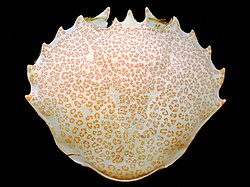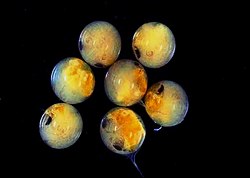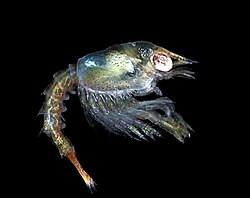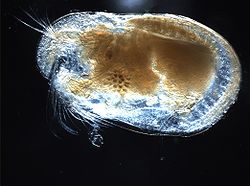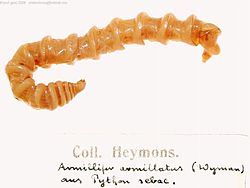Maxillopoda
Maxillopoda is a diverse class of crustaceans which includes the barnacles, copepods and a number of related animals.
| Maxillopoda Temporal range: Cambrian to Recent
| |
|---|---|

| |
| Cyclops (Copepoda: Cyclopoida) | |
| Scientific classification | |
| Kingdom: | |
| (unranked): | |
| Phylum: | |
| Subphylum: | |
| Class: | Maxillopoda |
| Sub-classes | |
| |
It does not appear to be a monophyletic group, and no single character unites all the members.[2]
Description
With the exception of some barnacles, maxillopodans are mostly small,[3] including the smallest known arthropod, Stygotantulus stocki.[2] They often have short bodies, with the abdomen reduced in size, and generally lacking any appendages [3] This may have arisen through paedomorphosis.[3]
Apart from barnacles, which use their legs for filter feeding, most maxillopodans feed with their maxillae. Their bodyplan has 5 head segments, 6 thoracic segments and 4 abdominal segments, followed by a telson (tailpiece).[4]
Fossil record
The fossil record of the group extends back into the Cambrian, with fossils of barnacles and tongue worms known from that period.[5][6]
Classification
Six subclasses are generally recognised, although many works have included the ostracods among the Maxillopoda.[2] Of the six groups, only Mystacocarida are entirely free-living; all the members of the Tantulocarida, Pentastomida and Branchiura are parasitic, and many of the Copepoda and Thecostraca are parasites.
Maxillopoda Media
A shed carapace of a lady crab, part of the hard exoskeleton
Eggs of Potamon fluviatile, a freshwater crab
Zoea larva of the European lobster, Homarus gammarus
Copepods, from Ernst Haeckel's 1904 work Kunstformen der Natur
References
| Wikimedia Commons has media related to Lua error in Module:Commons_link at line 62: attempt to index field 'wikibase' (a nil value).. |
- ↑ Maxillopoda (TSN {{{ID}}}). Integrated Taxonomic Information System.
- ↑ 2.0 2.1 2.2 Joel W. Martin & George E. Davis (2001). An updated classification of the Recent Crustacea (PDF). Natural History Museum of Los Angeles County. p. 132. Archived from the original (PDF) on 2013-05-12. Retrieved 2011-09-12.
- ↑ 3.0 3.1 3.2 "Introduction to Maxillopoda". University of California, Berkeley. Retrieved December 31, 2009.
- ↑ Phil Myers (2001). ""Maxillopoda"". Animal Diversity Web. Retrieved December 31, 2009.
- ↑ B.A. Foster & J.S. Buckeridge (1987). "Barnacle palaeontology". In A.J. Southward (ed.). Crustacean Issues 5: Barnacle biology. CRC Press. pp. 41–63. ISBN 90-6191-628-3.
- ↑ Lua error in Module:Citation/CS1/Identifiers at line 630: attempt to index field 'known_free_doi_registrants_t' (a nil value).
